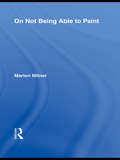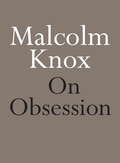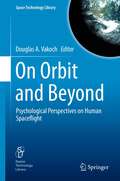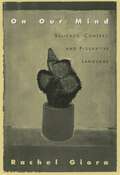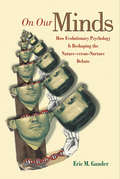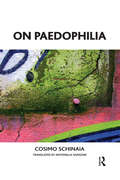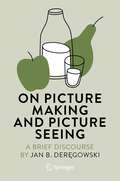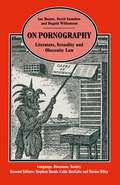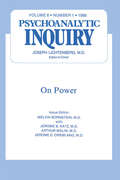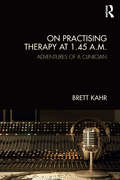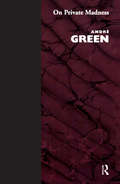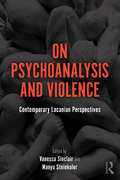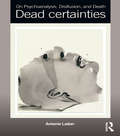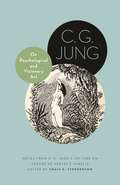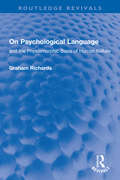- Table View
- List View
On Not Being Able to Paint
by Marion MilnerMilner’s great study, first published in 1950, discusses the nature of creativity and those forces which prevent its expression. In focusing on her own beginner’s efforts to draw and paint, she analyses not the mysterious and elusive ability of the genius but – as the title suggests – the all too common and distressing situation of ‘not being able’ to create. With a new introduction by Janet Sayers, this edition of On Not Being Able to Paint brings the text to the present generation of readers in the fields of psychoanalysis, education and all those, specialist and general audiences alike, with an interest or involvement in the creative process and those impulses impeding it in many fields.
On Not Being Able to Paint
by Marion MilnerMilner’s great study, first published in 1950, discusses the nature of creativity and those forces which prevent its expression. In focusing on her own beginner’s efforts to draw and paint, she analyses not the mysterious and elusive ability of the genius but – as the title suggests – the all too common and distressing situation of ‘not being able’ to create. With a new introduction by Janet Sayers, this edition of On Not Being Able to Paint brings the text to the present generation of readers in the fields of psychoanalysis, education and all those, specialist and general audiences alike, with an interest or involvement in the creative process and those impulses impeding it in many fields.
On Obsession (On Series)
by Malcolm Knox'When we are young adults, not only are we looking for signposts but we are afraid of ourselves, frightened of where our tendencies may lead. Are we all just a tiny bit mad, and were my obsessions, like my grandfather's, always going to take on a mild and manageable aspect?'In On Obsession, Malcolm Knox contemplates love, Proust, soulmates in fiction, palindromic numbers and bloodlines, among other fixations, and wonders if the obsessive quest marks a retreat from life.
On Orbit and Beyond: Psychological Perspectives on Human Spaceflight (Space Technology Library #29)
by Douglas A. VakochAs we stand poised on the verge of a new era of spaceflight, we must rethink every element, including the human dimension. This book explores some of the contributions of psychology to yesterday’s great space race, today’s orbiter and International Space Station missions, and tomorrow’s journeys beyond Earth’s orbit. Early missions into space were typically brief, and crews were small, often drawn from a single nation. As international cooperation in space exploration has increased over the decades, the challenges of communicating across cultural boundaries and dealing with interpersonal conflicts have become all the more important, requiring different coping skills and sensibilities than “the right stuff” expected of early astronauts. As astronauts travel to asteroids or establish a permanent colony on the Moon, with the eventual goal of reaching Mars, the duration of expeditions will increase markedly, as will the psychosocial stresses. Away from their home planet for extended times, future spacefarers will need to be increasingly self-sufficient, while simultaneously dealing with the complexities of heterogeneous, multicultural crews."On Orbit and Beyond: Psychological Perspectives on Human Spaceflight," the second, considerably expanded edition of "Psychology of Space Exploration: Contemporary Research in Historical Perspective," provides an analysis of these and other challenges facing future space explorers while at the same time presenting new empirical research on topics ranging from simulation studies of commercial spaceflights to the psychological benefits of viewing Earth from space. This second edition includes an all new section exploring the challenges astronauts will encounter as they travel to asteroids, Mars, Saturn, and the stars, requiring an unprecedented level of autonomy. Updated essays discuss the increasingly important role of China in human spaceflight. In addition to examining contemporary psychological research, several of the essays also explicitly address the history of the psychology of space exploration. Leading contributors to the field place the latest theories and empirical findings in historical context by exploring changes in space missions over the past half century, as well as reviewing developments in the psychological sciences during the same period. The essays are innovative in their approaches and conclusions, providing novel insights for behavioral researchers and historians alike.
On Our Mind: Salience, Context, and Figurative Language
by Rachel GioraHow do we learn to produce and comprehend non-literal language? Competing theories have only partially accounted for the variety of language comprehension evoked in metaphor, irony, and jokes. Rachel Giora has developed a novel and comprehensive theory, the Graded Salience Hypothesis, to explain figuative language comprehension. Giora contends that the salience of meanings (i.e., the cognitive priority we ascribe to words encoded in our mental lexicon) has the primary role in language comprehension and production.
On Our Minds: How Evolutionary Psychology Is Reshaping the Nature versus Nurture Debate
by Eric M. GanderThere is no question more fundamental to human existence than that posed by the nature-versus-nurture debate. For much of the past century, it was widely believed that there was no essential human nature and that people could be educated or socialized to thrive in almost any imaginable culture. Today, that orthodoxy is being directly and forcefully challenged by a new science of the mind: evolutionary psychology. Like the theory of evolution itself, the implications of evolutionary psychology are provocative and unsettling. Rather than viewing the human mind as a mysterious black box or a blank slate, evolutionary psychologists see it as a physical organ that has evolved to process certain types of information in certain ways that enables us to thrive only in certain types of cultures.In On Our Minds, Eric M. Gander examines all sides of the public debate between evolutionary psychologists and their critics. Paying particularly close attention to the popular science writings of Steven Pinker, Edward O. Wilson, Richard Dawkins, and Stephen Jay Gould, Gander traces the history of the controversy, succinctly summarizes the claims and theories of the evolutionary psychologists, dissects the various arguments deployed by each side, and considers in detail the far-reaching ramifications—social, cultural, and political—of this debate. Gander's lucid and highly readable account concludes that evolutionary psychology now holds the potential to answer our oldest and most profound moral and philosophical questions, fundamentally changing our self–perception as a species.
On Paedophilia
by Cosimo SchinaiaThis book deepens the communicative dynamics by which even through the mass media the paedophile has become the plague-spreader. It is an attempt to underline that only an integrative approach can give an appropriate answer to the clinical complexity characterising paedophilic pictures.
On Paedophilia
by Cosimo SchinaiaThis book deepens the communicative dynamics by which even through the mass media the paedophile has become the plague-spreader. It is an attempt to underline that only an integrative approach can give an appropriate answer to the clinical complexity characterising paedophilic pictures.
On Picture Making and Picture Seeing: A Brief Discourse (Vision, Illusion and Perception #4)
by Jan B. DeręgowskiArchaeological and anthropological investigations of depictions seldom extend beyond a single culture or a single geographical location, although there is a powerful factor common to all depictions, the factor of human perception. In this volume an attempt is made to show how this factor affects both creation and recognition of depictions, how, in common with everyday vision of the environment, typical contours are derived and used, not merely to depict individually readily recognisable models, but also how by concatenation they lead to such a splendid figure as Australian Kakadu crocodiles, or by distortion to creation of illusions of pictorial depth, such as is evoked by Leonardo da Vinci’s perspective and by inverted (Byzantine) perspective thought by some to be an aberration. Bartel’s studies show that pictorial depth is often achieved to the artist’s, and many a viewer’s, but not to geometer’s satisfaction by partial distortion, and Chinese masterpieces embody, side by side, ‘normal’ and inverted perspective. The visual process is universally uniform (if it were not, one would not be able to recognise an Altamira bison as a bison) and its foibles can be freely exploited. Its best known exploiter is probably Cezanne. His pictures are admired by many and puzzle many. Strzemiński postulated that they compound distinct lines of sight, thus endorsing primacy of central vision, a concept thought by Gombrich to be of greater import to geometers than to artists.
On Pornography: Literature, Sexuality and Obscenity Law (Language, Discourse, Society)
by David Saunders Dugald WilliamsonThe policing of pornography remains a subject of widespread controversy. On Pornography provides a history of this policing and an understanding of the current debate. The authors show that obscenity law should not be understood negatively as censorship but as part of the positive administration of a particular practice of sexuality. This book indicates that obscenity law is not, as liberals claim, a mistaken attempt to police moral ideas, but rather forms part of the legitimate governmental regulation of a problematic social conduct.
On Power: Psychoanalytic Inquiry, 6.1
by Melvin BornsteinFirst published in 1995. Routledge is an imprint of Taylor & Francis, an informa company.
On Power: Psychoanalytic Inquiry, 6.1
by Melvin BornsteinFirst published in 1995. Routledge is an imprint of Taylor & Francis, an informa company.
On Practising Therapy at 1.45 A.M.: Adventures of a Clinician
by Brett KahrAlthough Professor Kahr spends most of his week facilitating traditional psychoanalytical sessions with his patients, in his spare time he has had many professional adventures outside the consulting room, broadcasting as Resident Psychotherapist for the B.B.C., lecturing about the intimacies of couple psychodynamics on the stage of the Royal Opera House, and defending “Lady Macbeth” in a murder trial at the Royal Courts of Justice in conjunction with members of the Royal Shakespeare Company. In this compellingly written and unputdownable book, Kahr shares his wealth of adventures both inside the consulting room and in the wider cultural sphere, disseminating psychoanalytical ideas more broadly. The book suggests that the “traditionalist” and the “maverick” aspects of the practising clinician can exist side by side in a fruitful collaboration. These adventures will encourage those embarking upon their first steps in the helping professions to entertain more creative ways of working.
On Practising Therapy at 1.45 A.M.: Adventures of a Clinician
by Brett KahrAlthough Professor Kahr spends most of his week facilitating traditional psychoanalytical sessions with his patients, in his spare time he has had many professional adventures outside the consulting room, broadcasting as Resident Psychotherapist for the B.B.C., lecturing about the intimacies of couple psychodynamics on the stage of the Royal Opera House, and defending “Lady Macbeth” in a murder trial at the Royal Courts of Justice in conjunction with members of the Royal Shakespeare Company. In this compellingly written and unputdownable book, Kahr shares his wealth of adventures both inside the consulting room and in the wider cultural sphere, disseminating psychoanalytical ideas more broadly. The book suggests that the “traditionalist” and the “maverick” aspects of the practising clinician can exist side by side in a fruitful collaboration. These adventures will encourage those embarking upon their first steps in the helping professions to entertain more creative ways of working.
On Private Madness
by Andre GreenThe author occupies a unique position in psychoanalysis today, and his work represents a synthesis of the traditions of Lacan, Winnicott and Bion. This volume collects fourteen of his papers together with a substantial introduction. The papers range widely across clinical and theoretical issues including borderline states, the true and false self, and narcissism. On Private Madness has achieved the status of a modern psychoanalytic classic, and this new impression will be welcomed by all those admirers of the author who wish to have these seminal papers collected together.
On Private Madness
by Andre GreenThe author occupies a unique position in psychoanalysis today, and his work represents a synthesis of the traditions of Lacan, Winnicott and Bion. This volume collects fourteen of his papers together with a substantial introduction. The papers range widely across clinical and theoretical issues including borderline states, the true and false self, and narcissism. On Private Madness has achieved the status of a modern psychoanalytic classic, and this new impression will be welcomed by all those admirers of the author who wish to have these seminal papers collected together.
On Psychoanalysis and Violence: Contemporary Lacanian Perspectives
by Vanessa Sinclair Manya SteinkolerPsychoanalysis has not examined violence as such since it is a sociological and criminological concept; psychoanalysis is concerned with speech. On Psychoanalysis and Violence brings together noted Lacanian psychoanalysts and scholars to fill an important gap in psychoanalytic scholarship that addresses what the contributors term the "angwash" of our current time. Today violence is everywhere. We are inundated with it, exhausted by it, bombarded by images and reports of it on a daily, even hourly basis. This book examines how psychoanalysis can account for the many manifestations of violence in contemporary society. Drawing on a broadly Lacanian perspective, the authors explore violence in war, terrorism, how the media portrays violence, violent video games, questions of identity, difference and the ‘other’; violence narratives and violence and DSM, and explain how to account for how violence arises and the effect it has on us on both an individual and social level. These are just some of the daily social realities of the present day whose aggression are felt by everyone, which horrify us and which we often feel powerless to change. The contributors have therefore coined a term for this cultural malaise: "angwash", arguing that we are awash in angoisse or anxiety, in a constant panic regarding the impossible and contradictory demands of a "civilization" in crisis. On Psychoanalysis and Violence will be of great interest to Lacanian psychoanalysts and psychoanalytic psychotherapists.
On Psychoanalysis and Violence: Contemporary Lacanian Perspectives
by Vanessa Sinclair Manya SteinkolerPsychoanalysis has not examined violence as such since it is a sociological and criminological concept; psychoanalysis is concerned with speech. On Psychoanalysis and Violence brings together noted Lacanian psychoanalysts and scholars to fill an important gap in psychoanalytic scholarship that addresses what the contributors term the "angwash" of our current time. Today violence is everywhere. We are inundated with it, exhausted by it, bombarded by images and reports of it on a daily, even hourly basis. This book examines how psychoanalysis can account for the many manifestations of violence in contemporary society. Drawing on a broadly Lacanian perspective, the authors explore violence in war, terrorism, how the media portrays violence, violent video games, questions of identity, difference and the ‘other’; violence narratives and violence and DSM, and explain how to account for how violence arises and the effect it has on us on both an individual and social level. These are just some of the daily social realities of the present day whose aggression are felt by everyone, which horrify us and which we often feel powerless to change. The contributors have therefore coined a term for this cultural malaise: "angwash", arguing that we are awash in angoisse or anxiety, in a constant panic regarding the impossible and contradictory demands of a "civilization" in crisis. On Psychoanalysis and Violence will be of great interest to Lacanian psychoanalysts and psychoanalytic psychotherapists.
On Psychoanalysis, Disillusion, and Death: Dead certainties
by Antonie LadanFor some years now, psychoanalysts have been trying to understand the implications of neuroscientific findings for psychoanalytic theory and practice. In On Psychoanalysis, Disillusion, and Death: Dead certainties Antonie Ladan looks at how findings from neuroscience and memory research can inform our understanding of some of the most important psychoanalytic concepts, such as transference and unconscious fantasy. Central to the book are the 'dead certainties' that, to a great extent, determine how we lead our lives. Antonie Ladan argues that these certainties are too self-evident to be seen, as invisible as the air we breathe. He shows how in our associations with others, we are in large measure 'guided' by 'dead certain' relational patterns of which we are not conscious, but that remain implicit. Using clinical examples, Ladan illustrates how a specific form of observation, where the analysand and the analyst pay careful attention to their relationship over an extended period of time, makes it possible to gradually recognise these automatic expectations and behaviours in relational situations. On Psychoanalysis, Disillusion, and Death explores how the psychoanalyst can bring the implicit patterns, within which analysands find themselves trapped, to their attention enabling them to look at the world from a 'disillusioning' perspective in order to accept life and the prospect of death for what they are. This book will be of interest to psychotherapists, analytical psychologists, psychoanalysts, therapists and students.
On Psychoanalysis, Disillusion, and Death: Dead certainties
by Antonie LadanFor some years now, psychoanalysts have been trying to understand the implications of neuroscientific findings for psychoanalytic theory and practice. In On Psychoanalysis, Disillusion, and Death: Dead certainties Antonie Ladan looks at how findings from neuroscience and memory research can inform our understanding of some of the most important psychoanalytic concepts, such as transference and unconscious fantasy. Central to the book are the 'dead certainties' that, to a great extent, determine how we lead our lives. Antonie Ladan argues that these certainties are too self-evident to be seen, as invisible as the air we breathe. He shows how in our associations with others, we are in large measure 'guided' by 'dead certain' relational patterns of which we are not conscious, but that remain implicit. Using clinical examples, Ladan illustrates how a specific form of observation, where the analysand and the analyst pay careful attention to their relationship over an extended period of time, makes it possible to gradually recognise these automatic expectations and behaviours in relational situations. On Psychoanalysis, Disillusion, and Death explores how the psychoanalyst can bring the implicit patterns, within which analysands find themselves trapped, to their attention enabling them to look at the world from a 'disillusioning' perspective in order to accept life and the prospect of death for what they are. This book will be of interest to psychotherapists, analytical psychologists, psychoanalysts, therapists and students.
On Psychological and Visionary Art: Notes from C. G. Jung’s Lecture on Gérard de Nerval's Aurélia (Philemon Foundation Series #12)
by C. G. JungFor the first time in English, Jung's landmark lecture on Nerval's hallucinatory memoirIn 1945, at the end of the Second World War and after a long illness, C. G. Jung delivered a lecture in Zürich on the French Romantic poet Gérard de Nerval. The lecture focused on Nerval's visionary memoir, Aurélia, which the poet wrote in an ambivalent attempt to emerge from madness. Published here for the first time, Jung’s lecture is both a cautionary psychological tale and a validation of Nerval’s visionary experience as a genuine encounter.Nerval explored the irrational with lucidity and exquisite craft. He privileged the subjective imagination as a way of fathoming the divine to reconnect with what the Romantics called the life principle. During the years of his greatest creativity, he suffered from madness and was institutionalized eight times. Contrasting an orthodox psychoanalytic interpretation with his own synthetic approach to the unconscious, Jung explains why Nerval was unable to make use of his visionary experiences in his own life. At the same time, Jung emphasizes the validity of Nerval’s visions, differentiating the psychology of a work of art from the psychology of the artist. The lecture suggests how Jung’s own experiments with active imagination influenced his reading of Nerval’s Aurélia as a parallel text to his own Red Book.With Craig Stephenson’s authoritative introduction, Richard Sieburth’s award-winning translation of Aurélia, and Alfred Kubin’s haunting illustrations to the text, and featuring Jung’s reading marginalia, preliminary notes, and revisions to a 1942 lecture, On Psychological and Visionary Art documents the stages of Jung’s creative process as he responds to an essential Romantic text.
On Psychological and Visionary Art: Notes from C. G. Jung’s Lecture on Gérard de Nerval’s "Aurélia"
by C. G. Jung Craig E. StephensonIn 1945, at the end of the Second World War and after a long illness, C. G. Jung delivered a lecture in Zürich on the French Romantic poet Gérard de Nerval. The lecture focused on Nerval's visionary memoir, Aurélia, which the poet wrote in an ambivalent attempt to emerge from madness. Published here for the first time, Jung’s lecture is both a cautionary psychological tale and a validation of Nerval’s visionary experience as a genuine encounter.Nerval explored the irrational with lucidity and exquisite craft. He privileged the subjective imagination as a way of fathoming the divine to reconnect with what the Romantics called the life principle. During the years of his greatest creativity, he suffered from madness and was institutionalized eight times. Contrasting an orthodox psychoanalytic interpretation with his own synthetic approach to the unconscious, Jung explains why Nerval was unable to make use of his visionary experiences in his own life. At the same time, Jung emphasizes the validity of Nerval’s visions, differentiating the psychology of a work of art from the psychology of the artist. The lecture suggests how Jung’s own experiments with active imagination influenced his reading of Nerval’s Aurélia as a parallel text to his own Red Book.With Craig Stephenson’s authoritative introduction, Richard Sieburth’s award-winning translation of Aurélia, and Alfred Kubin’s haunting illustrations to the text, and featuring Jung’s reading marginalia, preliminary notes, and revisions to a 1942 lecture, On Psychological and Visionary Art documents the stages of Jung’s creative process as he responds to an essential Romantic text.
On Psychological and Visionary Art: Notes from C. G. Jung’s Lecture on Gérard de Nerval’s "Aurélia"
by C. G. Jung Craig E. StephensonIn 1945, at the end of the Second World War and after a long illness, C. G. Jung delivered a lecture in Zürich on the French Romantic poet Gérard de Nerval. The lecture focused on Nerval's visionary memoir, Aurélia, which the poet wrote in an ambivalent attempt to emerge from madness. Published here for the first time, Jung’s lecture is both a cautionary psychological tale and a validation of Nerval’s visionary experience as a genuine encounter.Nerval explored the irrational with lucidity and exquisite craft. He privileged the subjective imagination as a way of fathoming the divine to reconnect with what the Romantics called the life principle. During the years of his greatest creativity, he suffered from madness and was institutionalized eight times. Contrasting an orthodox psychoanalytic interpretation with his own synthetic approach to the unconscious, Jung explains why Nerval was unable to make use of his visionary experiences in his own life. At the same time, Jung emphasizes the validity of Nerval’s visions, differentiating the psychology of a work of art from the psychology of the artist. The lecture suggests how Jung’s own experiments with active imagination influenced his reading of Nerval’s Aurélia as a parallel text to his own Red Book.With Craig Stephenson’s authoritative introduction, Richard Sieburth’s award-winning translation of Aurélia, and Alfred Kubin’s haunting illustrations to the text, and featuring Jung’s reading marginalia, preliminary notes, and revisions to a 1942 lecture, On Psychological and Visionary Art documents the stages of Jung’s creative process as he responds to an essential Romantic text.
On Psychological Language: and the Physiomorphic Basis of Human Nature (Routledge Revivals)
by Graham RichardsFirst published in 1989, On Psychological Language and the Physiomorphic Basis of Human Nature was written to provide a new and controversial analysis of the nature of psychological language. The book argues that psychological concepts of all kinds are ultimately derived from concepts about the external world, so that ‘human nature’ is nothing more than ‘internalized Nature’. It draws attention to problems regarding the nature of linguistic reference, and puts forward a route for considering human psychological evolution, raising questions about the nature of psychology as a discipline and its relationship with the physical sciences. This ‘physiomorphic theory’ challenged ways of thinking about psychological language at the time of original publication. Interdisciplinary in its approach, On Psychological Language and the Physiomorphic Basis of Human Nature has enduring relevance for those with an interest in psychology, anthropology, philosophy, and linguistics.
On Psychological Language: and the Physiomorphic Basis of Human Nature (Routledge Revivals)
by Graham RichardsFirst published in 1989, On Psychological Language and the Physiomorphic Basis of Human Nature was written to provide a new and controversial analysis of the nature of psychological language. The book argues that psychological concepts of all kinds are ultimately derived from concepts about the external world, so that ‘human nature’ is nothing more than ‘internalized Nature’. It draws attention to problems regarding the nature of linguistic reference, and puts forward a route for considering human psychological evolution, raising questions about the nature of psychology as a discipline and its relationship with the physical sciences. This ‘physiomorphic theory’ challenged ways of thinking about psychological language at the time of original publication. Interdisciplinary in its approach, On Psychological Language and the Physiomorphic Basis of Human Nature has enduring relevance for those with an interest in psychology, anthropology, philosophy, and linguistics.
